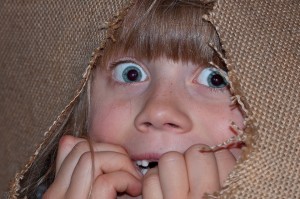 When your child is having a meltdown, it can be hard to stop and consider what emotions are causing this behavior. All you want is for the screaming to cease, so the lovely people around you can quit giving you side-eye-glances. But, as parents, we need to understand the mechanisms at work inside of our offspring’s brains, if we have any chance at helping said offspring understand themselves.
When your child is having a meltdown, it can be hard to stop and consider what emotions are causing this behavior. All you want is for the screaming to cease, so the lovely people around you can quit giving you side-eye-glances. But, as parents, we need to understand the mechanisms at work inside of our offspring’s brains, if we have any chance at helping said offspring understand themselves.
Anxiety shows up in the brain as an activated response from the amygdala, the part of the brain that regulates our fight or flight response. When the amygdala senses that we are in any type of danger, (real or imagined), it sends hormones, (such as the stress hormone, cortisol), into the bloodstream. Physically, we can feel symptoms like: nervousness, shakiness, shortness of breath, and a host of other sensations as a result of these hormones. And children, in particular, often experience clammy hands, stomach-aches, headaches, and nausea, which can cause them to act out.
How each child acts in response to these physical symptoms depends on the child and the situation. Some children will display avoidant behaviors, such as not wanting to go to school, or ignoring their friends when they feel anxious. Others, may regress or become “clingy” with parents, while still others may display anger as a defense against what they are feeling inside. And, to make matters more complicated, the same child might react in all three of these ways on different occasions.
What’s important to know about anger, is that it often isn’t what it seems. Especially in children. Many times when kids act in angry ways, it is because they either: 1) don’t understand what is happening inside of them, or 2) are not connecting with their inner emotions because that would feel too scary.
If we, as caregivers, can recognize anger as a “second-level-emotion,” one that is lying on top of a softer, more vulnerable state, then we may be able to approach the situation with some much-needed compassion.
But compassion alone won’t solve the problem. We also need to teach our kids how to effectively manage their emotions. We do this using a three step approach:
First, we teach children to be aware of what is happening inside of them. We help them learn to identify what they are feeling, and to name their experience. This puts the locus of control back on the child, so they can gain a sense of empowerment.
Second, we help children learn important coping skills, like breathing, counting to ten, drawing their emotions, and remembering calming phrases, that can help them through those difficult moments.
And, finally, we reframe the problem, by helping our children to see that their response means that their brains are actually working. Then we enlist our little one’s help in coming up with creative ways to redefine their experience. Maybe, instead of having a meltdown, they turn themselves into a superhero every time they start to feel uncomfortable. Your kid’s cape still may get you side-eye-glances from the other shoppers at the store, but your child will feel safe, which, in turn, will make you feel like a super parent.
If you would like more information on how to help a child with anger, anxiety, or any emotional issue, contact us. We are here to help.
